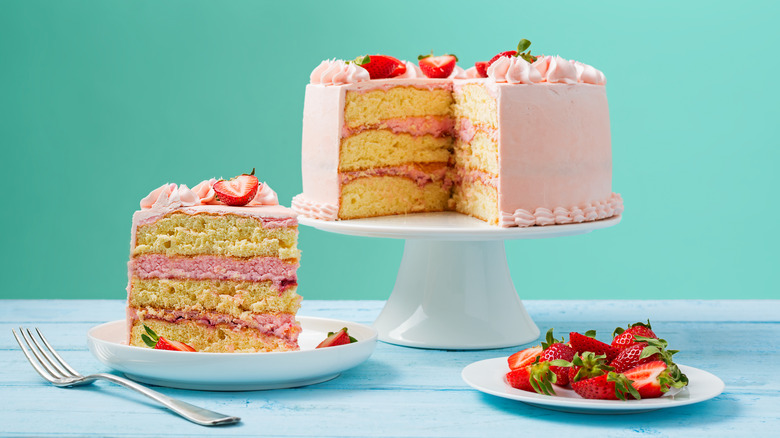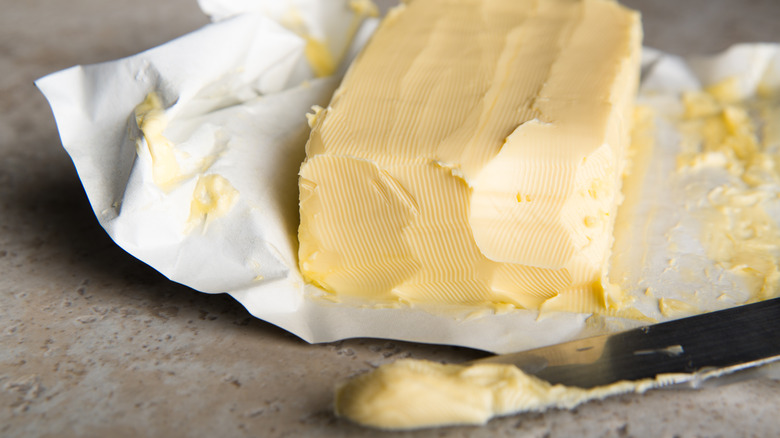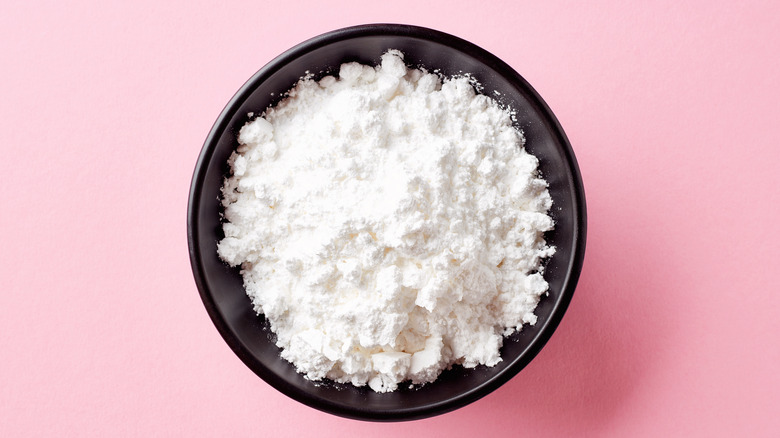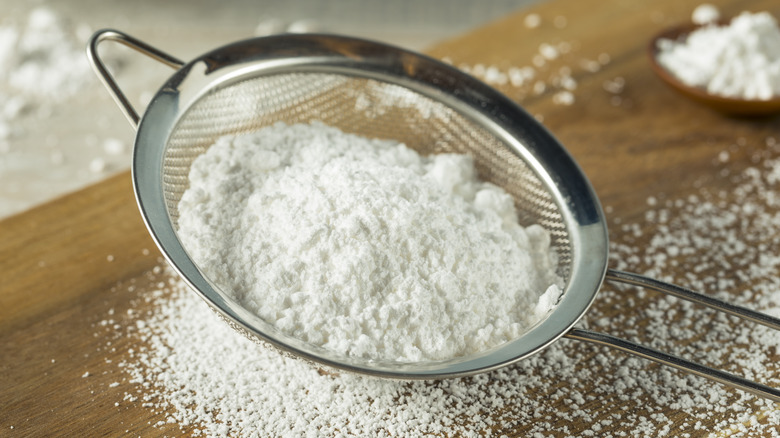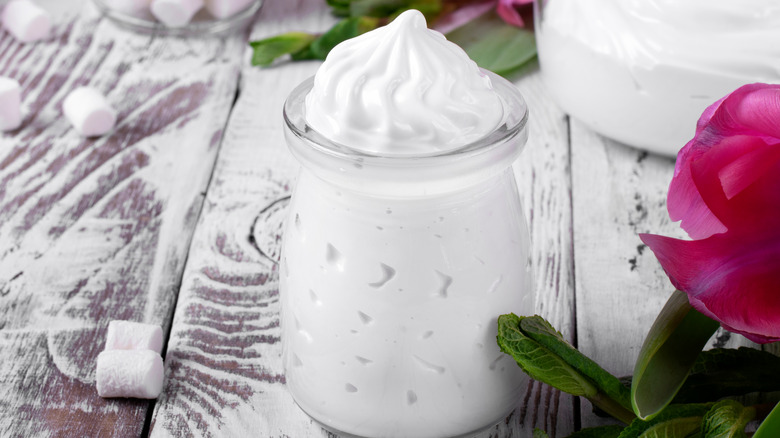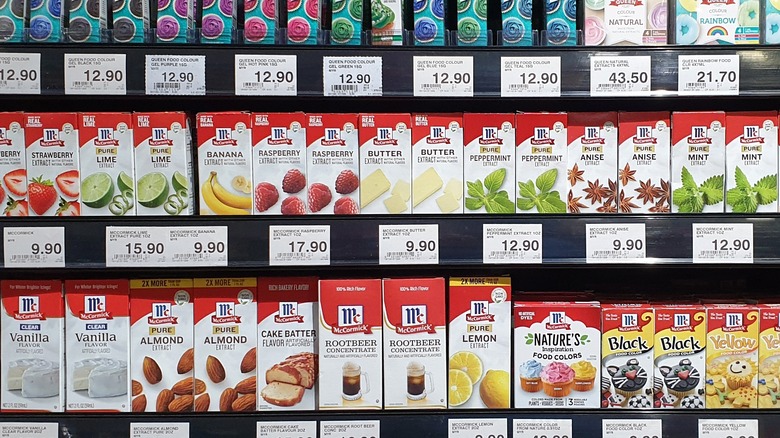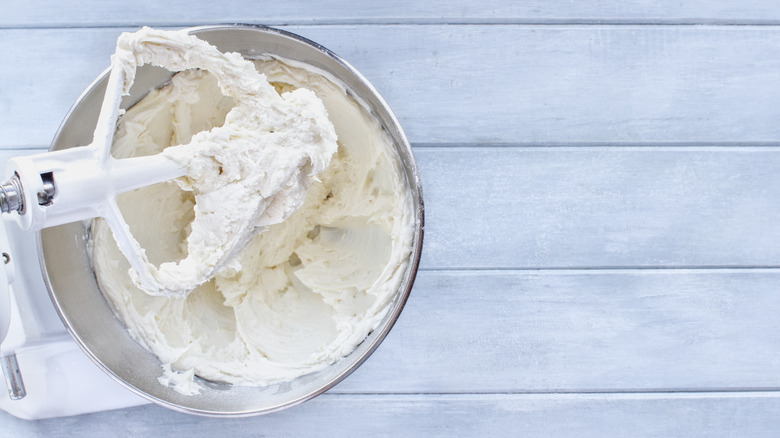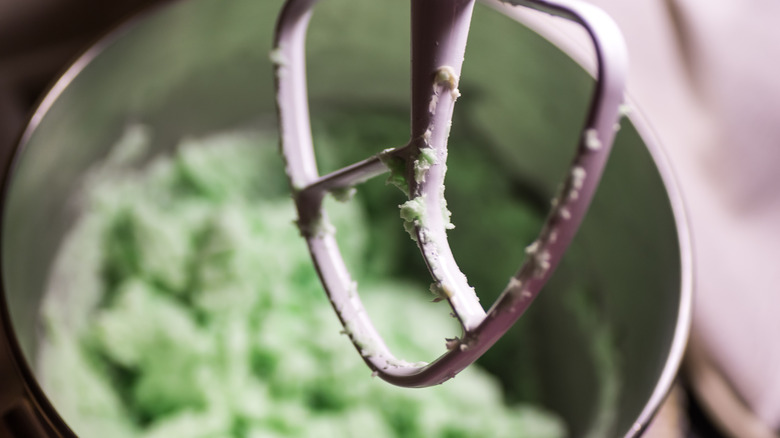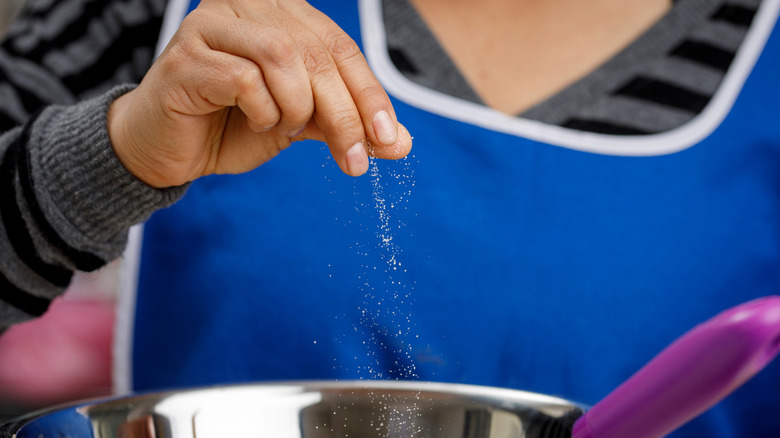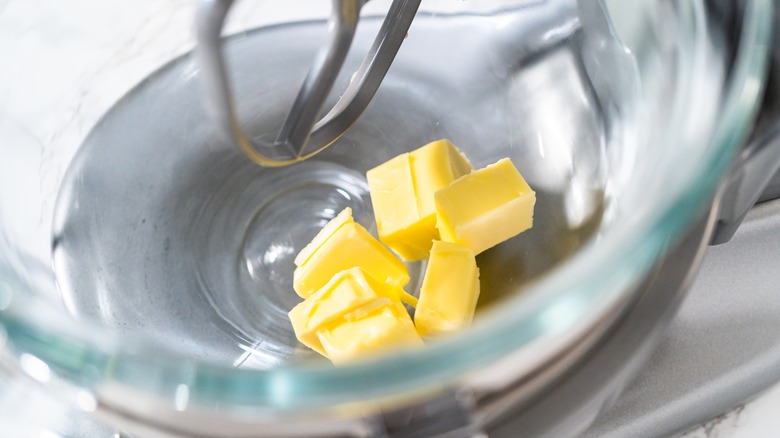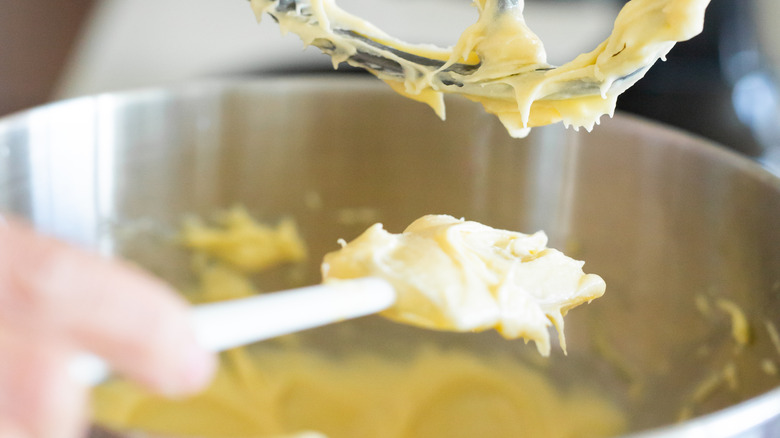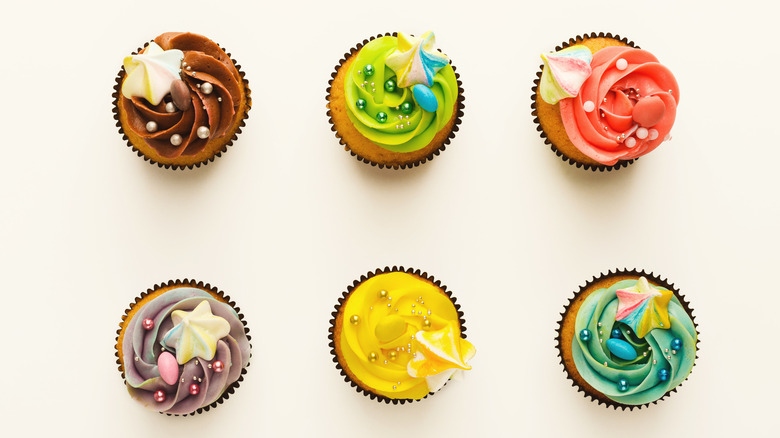15 Tips To Improve Your Buttercream Frosting
If you've ever dug into a piece of decadent birthday cake with creamy frosting, you likely had the honor of tasting a homemade buttercream. Of course, not all cakes are made with buttercream, but it is a much-appreciated delicacy and used for all sorts of sweet treats. You can create this fluffy spread in several ways; in fact, there are many different types of it out there, like German and Swiss buttercream, for example. But when making classic American buttercream, you only need a few simple ingredients. Typically, it is a velvety mixture made from butter, powdered sugar, a dash of salt, and a splash of milk (vanilla extract is also a staple for many).
Although this frosting only requires a handful of ingredients, it can actually be quite easy to mess up. Learning different techniques to use when making buttercream frosting can make a world of difference in how it turns out. If you want your buttercream to be cloud-like, flavorful, and easy on the eyes, following these tips and tricks will help you get there.
Use real butter
One of the most crucial steps in making scrumptious buttercream is to make it using real butter. It can be tempting to use alternatives for butter in a pinch, like shortening or margarine. The problem with using these products is that they severely lack the rich flavor that butter naturally has, which is why you should never use a butter substitute in buttercream frosting. Not only will the frosting taste subpar when you don't make it with the real deal, but it will also have a different consistency.
Shortening is very oily, while margarine tends to contain water that would not be ideal for your frosting. So, when shopping for your baking ingredients, pay close attention to the butter product you buy. Some might appear as being real butter when, in reality, they are a blend or spread that mimics the creamy and indulgent butter everyone loves so dearly.
Make sure the butter is at room temperature
Room-temperature butter is essential when making buttercream, and there are a few reasons why. The first reason is that using cold butter can negatively affect the outcome of the frosting's texture. When the butter is rock-hard, it doesn't beautifully whip into a pillowy consistency; no matter how hard you beat it, the frosting will still be full of lumps. In addition, using chilled butter can cause the frosting to separate, making it appear like cottage cheese, and nobody wants that.
Lastly, you shouldn't beat cold butter with your mixer because it can damage the machine. It can potentially put unnecessary wear and tear on the motor, which can shorten your appliance's life span. With all this in mind, the clear solution is to leave the butter sitting out for a while before making the frosting. Thinking ahead and pulling it from the fridge to soften it will give you the results you are hoping to achieve. You'll likely never look back once you work with room-temperature butter.
Use powdered sugar instead of granulated sugar
If you use the wrong sugar when making frosting, it could be the reason why your buttercream is grainy. Although some people might think the type of sugar used wouldn't make much of a difference, this is unfortunately false; powdered sugar is the way to go every single time. In simple terms, confectioners' sugar is light and soft on its own, so when it becomes whipped with butter, it makes for dreamy buttercream. On the other hand, using granulated sugar can be disastrous to your frosting because of its sandy texture.
If you've found yourself in a pickle and don't have powdered sugar on hand, don't worry — it is possible to make powdered sugar from granulated sugar. All you need is a high-performance blender, cornstarch, and granulated sugar. The correct cornstarch to granulated sugar ratio would be 1 tablespoon to 1 cup. Place the ingredients into the blender and blend it for half a minute to create your own confectioners' sugar in a pinch.
Sift the powdered sugar
Another way to guarantee that your buttercream turns out lump-free is by sifting the powdered sugar before using it. Failing to sift certain ingredients is one of the biggest mistakes you can make while baking in general. The practice of sifting removes all the unwanted clumps from flour, sugar, and other dry ingredients and makes them airier and lighter. So, what should you do if you don't own a sifter? Fear not — you can still learn how to sift ingredients if you don't have a sieve.
As with flour, you can simply use a whisk to break up the clusters of sugar that have formed, breaking down the confectioners' sugar into a finer consistency. Although it won't necessarily be as light as a sieve would make it, this easy practice will undoubtedly be helpful. Sifting can seem like a hassle, but you will be thankful you took the time to do it when you observe how much of a difference it truly makes with your frosting.
Add marshmallow fluff to make it hold shape
Here is a baking hack that can be a game-changer for many. Have you ever worked with buttercream that wasn't holding its shape quite as you wanted it to? To avoid this, you might want to try using an unexpected ingredient for better buttercream frosting: marshmallow fluff. It's no secret that marshmallow fluff is whimsically delicious, but add it to buttercream, and well, you can only imagine just how delightful it is. This addition would surely step up the flavor of your frosting while also making its texture a bit different (in a good way).
Particular cakes and desserts you create might require frosting that stays put, meaning that the frosting can't be too loose. This is where the marshmallow fluff comes in and saves the day. The best part is that you can experiment and add as much or little as you feel is needed. Taste it as you go and test the consistency to your heart's content. It is always wise to start with a small amount, then add more if needed.
Add cornstarch to make it less runny
Sometimes when making buttercream, you might add too much vanilla extract or other liquids, making the frosting runny. If you have already added the perfect amount of powdered sugar, adding more might not be the best route of action because it can make the frosting overly sweet. Adding a bit of cornstarch to the buttercream can do wonders in this instance. The best part about using cornstarch for bulking up the frosting is that it won't noticeably alter the flavor. If you're tired of runny frosting, this simple tip is key, and it is quite easy to execute.
For every cup of confectioners' sugar, you can use a teaspoon of cornstarch. For best results, don't mix the cornstarch straight into the frosting (this can cause lumping). But instead, make a slurry with just enough milk or cream so that the cornstarch efficiently can dissolve. Adding more liquid to the frosting might seem a bit counteractive, but the cornstarch will do its job. So, don't throw out your frosting next time it's runny; it isn't beyond repair.
Use heavy cream instead of milk
Have you ever wondered why homemade frosting doesn't compare to bakery frosting sometimes? You'll be happy to learn that the key ingredient swap that gives frosting bakery-like richness every time is heavy cream. Rather than using milk to make your frosting creamy, use heavy cream, and you will see a clear difference. It will not only give a deeper flavor than milk would, but the consistency is better too. Since the heavy cream is on the thicker side, it has less of a chance of thinning out the frosting too much.
You can credit both the better taste and texture to the high amount of butterfat in the product. When comparing milk to cream, milk has more than 30% less butterfat than cream, so it makes sense why there is such a noticeable contrast. The switch is easy because you don't need to change the recipe's amount. Simply substitute the total amount of milk with heavy cream, and voila.
Add flavoring ingredients
One sure way to step up your buttercream game is to upgrade it with different flavors. In truth, not enriching it in some way is likely one of the mistakes you're making with homemade icing and frosting. Of course, the classic approach of using vanilla extract is always an option, and a solid one at that. It's no secret that vanilla tastes terrific with all ingredients and flavors, like chocolate, caramel, cinnamon, and fresh fruit. If you wanted the vanilla taste to be more prominent, you could always use vanilla paste or fresh vanilla beans. When it comes to switching it up, though, there are numerous other ways to flavor the frosting.
Other extracts like peppermint, almond, coconut, and banana are all fantastic options that could elevate the overall taste of your cake or baked goods. For coffee lovers, throwing a spritz of coffee liqueur into the frosting could give it a deep java flavor while also coloring the frosting. Lastly, if you don't have extracts or liqueurs, you can use ingredients you likely already have, like lemon juice or spices. Just be careful when using lemon juice because it is so thin; you'll have to account for it with powdered sugar to keep the frosting nice and thick.
Don't overmix it
If you're making your buttercream specifically for a cake or baked good where the frosting will be on full display, you'll want to be cautious not to over-whip it. If you do, large air pockets will start to form, which causes a change in texture. Obviously you want some air in your frosting to make it fluffy, but there is undoubtedly a fine line between silky buttercream and one that you can't smooth out.
To avoid this mistake that everyone makes when frosting a cake, you can pull the buttercream from the mixer when it has a spreadable consistency. Then, run a rubber spatula through the frosting in the bowl and see how it feels; if it feels like there is resistance, it can still go longer. If you've found that the frosting already has visible air bubbles, fear not; this is a quick fix. Simply use the same spatula to smash the bubbles on the bowl edges, which will dissipate them.
Use a paddle attachment
Some recipes might call for using a whisk attachment, but for just about every type of buttercream, it is best to use the paddle for several reasons, per Mom's Baking Co. First, the paddle is best for creaming butter and sugar, no matter what you are baking. It does an excellent job of making the butter velvety-smooth, And when comparing a whisk to a paddle, the whisk will always incorporate more air into the food you're mixing. Having some air in the frosting is good, but a whisk can easily incorporate too much too quickly.
Not to mention, paddles are easier to handle when dealing with frosting. Thick foods like such tend to get trapped in the middle of the whisk. Using the paddle, you'll be able to scrape the frosting off effortlessly. Following this classic vanilla cake recipe is the perfect way to practice using your paddle when making buttercream (and using a whisk will soon be a thing of the past for you).
Add a pinch of salt
When following a recipe to make your frosting, you will probably notice how it typically has a tiny amount of salt listed in the ingredients. Some might wonder if such a small amount makes a difference, and they opt to leave it out of the recipe. But adding salt helps balance the flavors, which is why you should never omit salt in sweet recipes. Salt can help fix two problems: frosting that isn't sweet enough and frosting that is too sweet.
If the frosting tastes good but it feels like something is missing, adding just a pinch of salt can enhance the taste of the powdered sugar in the frosting and make it complete. This works similarly to adding espresso to chocolate desserts to intensify the taste of the chocolate. On the flip side, if your buttercream is too sugary to enjoy, adding a bit of salt to taste can help cut the sickly-sweet feel and harmonize all of the components. So, either way, your best bet is to include the salt in your frosting.
Cream butter first before adding sugar
One effortless way to create the buttercream of your dreams is to follow the correct order in which you add the ingredients. You'll want to start creaming the butter before incorporating anything else. Although it might be tempting to toss everything in the bowl and assume it'll perfectly blend, it doesn't always work that way. Instead, try mixing the room-temperature butter until it becomes paler in color; the texture should be lighter, too. Then, go ahead and add the sugar, but do so in stages. This way, the mixture has time to adjust to the additions, and everything can blend smoothly.
If you don't own a stand mixer, there is always the option to do it by hand using a bit of elbow grease. Follow the same method, whipping the butter first. Doing this will aid the frosting into being smooth; that way, you can use it with all sorts of baked goods. After all, there are many different types of frostings and ways to use them, but buttercream is one of the most versatile of them all.
Scrape the sides of the bowl during the mixing process
The simple step of scraping down the bowl is vital when making classic buttercream frosting with a mixer. The mixer indeed catches many ingredients on its own, but its execution isn't always flawless. The wisest thing you can do is stop the mixer periodically, grab a rubber spatula, and scrape the sides of the bowl. You can also lower the bowl (if needed) to scrape the bottom, too, reaching completely under the attachment. In doing so, you will likely find extra butter or sugar clumps stuck to the sides and bottom.
If you were to bypass this step, it's possible that the final frosting would have components that weren't fully incorporated. That could lead to the buttercream having an uneven taste. Also, the extra butter on the sides would likely be harder than the fluffy frosting, so trying to blend it into the frosting at the last minute could create unwanted lumps. One thing is for sure, you won't regret putting your rubber spatula to good use here.
Use gel food coloring rather than liquid
Adding food dye to the frosting can be a fun way to customize and upgrade its appearance. Whether you want a simple colored frosting or a dessert with a rainbow of colors, edible colorant can be a baker's best friend. Although liquid food dye is very common and easily accessible, gel food coloring does a much better job. First, since it has a thicker consistency, it won't thin out your buttercream like the fluid version.
Using liquid coloring can be okay when you want a pale shade, but if you are hoping to attain a brighter or deeper color, the gel is certainly the way to go (via Queen Fine Foods). The other benefit of using gel is that a little goes a long way, so you use less product. A simple drop of gel pigment can give you the same result as several drops of fluid. Consider investing in gel coloring agents if you wish to step up your baking game.
Take your time
If baking from scratch is always better, why does it feel like homemade frosting is ruining your baked goods sometimes? The texture of the frosting plays a significant role in this. If you find that your buttercream doesn't look as appetizing as it should, you may have rushed the process. Pulling the frosting from the mixer prematurely can lead to unspreadable buttercream, making it hard to pipe because it is too stiff and heavy. In other words, if you don't give it enough time to mix, the ingredients won't fully mend together as they should. You want the elements to form into one, allowing the flavors to marry.
Part of making the perfect buttercream is finding the ideal balance of not under-mixing but also not over-mixing. Keep in mind that if your frosting was only on the mixer for a couple of minutes, it likely hasn't reached its full potential. Let it whip a bit longer while observing the consistency. There's no denying good things come to those who wait, and taking your time with buttercream is a perfect example of that.
